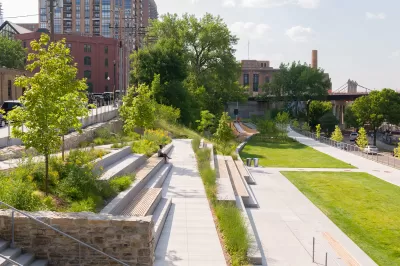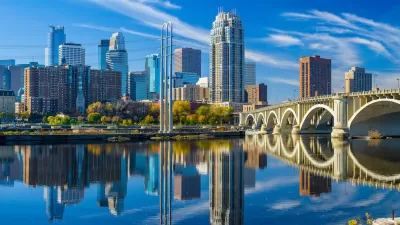The newly built Water Works Park and Pavilion incorporates elements of historic mills and provides amenities long absent from the city's waterfront.

Architecture critic Linda Mack describes Minneapolis' newest park, a "triumph" of redevelopment on the Mississippi River waterfront that finally gives residents a way to enjoy the view while having access to amenities like seating and public restrooms.
Built within the walls of two former mills, Water Works Park and Pavilion features walkways, benches, a playground, and the city's first Native American restaurant, a fitting tenant for a site that was sacred to the Dakota before white settlers came to the area. The development blends old and new elements to preserve sections of the historic buildings and utilize the remnants of the old mills to highlight the site's history as the engine of the city's economic growth. Mack writes,
Damon Farber Landscape Architects led the design team with HGA designing the pavilion, MacDonald and Mack as historic consultants, and the 106 Group as archaeologists. The Healing Place Collaborative brought in Dakota artists and language experts to design covers for the fire pits and interpret the rainwater collection and use of Native plants.
The property was purchased by the Minneapolis Park and Recreation Board in 1987, but sat in disrepair until a plan to build the park and pavilion finally took shape in 2011.
FULL STORY: Minneapolis’ newest park is like a front porch on the Mississippi River

Alabama: Trump Terminates Settlements for Black Communities Harmed By Raw Sewage
Trump deemed the landmark civil rights agreement “illegal DEI and environmental justice policy.”

Planetizen Federal Action Tracker
A weekly monitor of how Trump’s orders and actions are impacting planners and planning in America.

The 120 Year Old Tiny Home Villages That Sheltered San Francisco’s Earthquake Refugees
More than a century ago, San Francisco mobilized to house thousands of residents displaced by the 1906 earthquake. Could their strategy offer a model for the present?

San Francisco Opens Park on Former Great Highway
The Sunset Dunes park’s grand opening attracted both fans and detractors.

Oregon Legislature to Consider Transit Funding Laws
One proposal would increase the state’s payroll tax by .08% to fund transit agencies and expand service.

Housing Vouchers as a Key Piece of Houston’s Housing Strategy
The Houston Housing Authority supports 19,000 households through the housing voucher program.
Urban Design for Planners 1: Software Tools
This six-course series explores essential urban design concepts using open source software and equips planners with the tools they need to participate fully in the urban design process.
Planning for Universal Design
Learn the tools for implementing Universal Design in planning regulations.
Clanton & Associates, Inc.
Jessamine County Fiscal Court
Institute for Housing and Urban Development Studies (IHS)
City of Grandview
Harvard GSD Executive Education
Toledo-Lucas County Plan Commissions
Salt Lake City
NYU Wagner Graduate School of Public Service





























